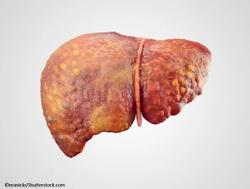© 2025 MJH Life Sciences™ , Patient Care Online – Primary Care News and Clinical Resources. All rights reserved.
Mediastinal Benign Schwannoma
The mediastinal benign schwannomas is a nerve sheath tumor composed of Schwann cells. These tumors are often asymptomatic and found incidentally.
A 35-year-old man with no significant past medical history, presents to the emergency department (ED) with worsening right shoulder pain. He reports that he fell on the ice and injured the right chest wall and right shoulder, 2 weeks prior to presentation. He states that his pain has been worsening at the site of injury. The pain is relieved with non-steroidal anti-inflammatory medications. He reports that just recently he has begun to feel numbness and tingling in the third, fourth, and fifth finger digits bilaterally. He denies head trauma. He also denies any fevers, chills, weight loss, or sick contacts. He has no dyspnea or cough and has no recent travel history. The patient is a non-smoker, works as a school teacher, and denies any occupational exposures.
Figures 1-4 were obtained in the ED; there were no prior images for comparison.
o What is your diagnosis in the setting of paresthesias and incidental radiographic findings after a fall?
o What are the treatment options?
- See more at: http://www.consultantlive.com/quiz/worsening-shoulder-pain-male-patient-after-fall-ice#sthash.cduCM3Nw.dpuf
A 35-year-old man with no significant past medical history, presents to the emergency department (ED) with worsening right shoulder pain. He reports that he fell on the ice and injured the right chest wall and right shoulder, 2 weeks prior to presentation. He states that his pain has been worsening at the site of injury. The pain is relieved with non-steroidal anti-inflammatory medications. He reports that just recently he has begun to feel numbness and tingling in the third, fourth, and fifth finger digits bilaterally. He denies head trauma. He also denies any fevers, chills, weight loss, or sick contacts. He has no dyspnea or cough and has no recent travel history. The patient is a non-smoker, works as a school teacher, and denies any occupational exposures.
Figures 1-4 were obtained in the ED; there were no prior images for comparison.
o What is your diagnosis in the setting of paresthesias and incidental radiographic findings after a fall?
o What are the treatment options?
- See more at: http://www.consultantlive.com/quiz/worsening-shoulder-pain-male-patient-after-fall-ice#sthash.cduCM3Nw.dpuf
A 35-year-old man with no significant past medical history, presents to the emergency department (ED) with worsening right shoulder pain. He reports that he fell on the ice and injured the right chest wall and right shoulder, 2 weeks before presentation. He states that his pain has been worsening at the site of injury. The pain is relieved with NSAIDs. He reports that just recently he has begun to feel numbness and tingling in the third, fourth, and fifth finger digits bilaterally. He denies head trauma. He also denies any fevers, chills, weight loss, or sick contacts. He has no dyspnea or cough and has no recent travel history. The patient is a nonsmoker, works as a school teacher, and denies any occupational exposures.
Figures 1-4 were obtained in the ED; there were no prior images for comparison.
• What is your diagnosis in the setting of paresthesias and incidental radiographic findings after a fall?
• What are the treatment options?
Diagnosis: Mediastinal benign schwannoma
Mediastinal benign schwannomas are often asymptomatic and found incidentally. This is a benign nerve sheath tumor composed of Schwann cells. These tumors most commonly present in the posterior aspect of the mediastinum. Schwannomas may cause symptoms related to compression of adjacent anatomical structures. These symptoms may include pain, dyspnea, cough, paresthesias, and Horner syndrome. The most common age group for this mediastinal neurogenic tumor is 30 to 50 years with an equal sex distribution.
Schwannomas are slow-growing, and malignant transformation of these tumors is rare. The tumors are well encapsulated, solitary, well circumscribed, grayish tan lesions that may contain cystic components. The tumors present with two patterns of growth: Antoni A area is a highly cellular pattern, composed of spindle cells that are often palisading; Antoni B area is a pattern of low cellularity separated by abundant edematous fluid which may form cystic spaces. Occasionally isolated cells with bizarre hyperchromatic nuclei are seen. Immunohistochemical studies reveal a strongly positive reaction with S-100 protein.
Treatment: Surgical resection
Despite the benign nature of the tumor and the fact that the risk of malignant change is low, surgical resection may be required for patients for diagnosis and for relief of symptoms. Surgical resection is usually performed by video-assisted thoracoscopy or thoracotomy.
References:
Suggested Reading
• Yamaguchi M, Yoshino I, Fukuyama S, et al. Surgical treatment of neurogenic tumors of the chest. Ann Thoracic Cardiovasc Surg. 2004;10:148-151. http://www.atcs.jp/pdf/2004_10_3/148.pdf
• Ortigara L, Rosemberg N, Siqueira R, Neto F. Case report: resection of a mediastinal schwannoma using video-assisted thoracoscopy. J Bras Pneumol. 2006;32:172-175. http://www.scielo.br/scielo.php?script=sci_arttext&pid=S1806-37132006000200013&lng=en&nrm=iso&tlng=en
• Fierro N, D’ermo G, Di Cola G, et al. Posterior mediastinal schwannoma. Asian Cardiovasc Thorac Ann. 2003;11:72-73. http://aan.sagepub.com/content/11/1/72.long
• Strollo DC, Rosado-de-Christenson ML, Jett JR. Primary mediastinal tumors: part II. Tumors of the middle and posterior mediastinum. Chest. 1997;112:1344-1357. http://journal.publications.chestnet.org/article.aspx?articleid=1071146



